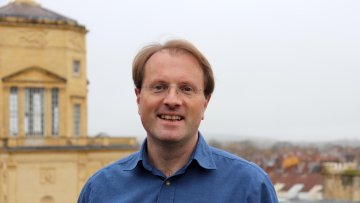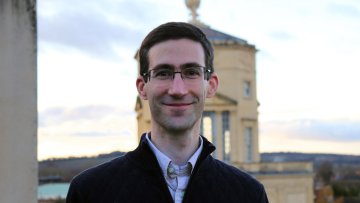Today, two Oxford mathematicians András Juhász and Marc Lackenby published a paper in Nature in collaboration with authors from DeepMind and with Geordie Williamson at the University of Sydney.
14:15
Chow quotients and geometric invariant theoretic quotients for group actions on complex projective varieties
The talk will be both online (Teams) and in person (L5)
Abstract
When a reductive group G acts on a complex projective variety
X, there exist different methods for finding an open G-invariant subset
of X with a geometric quotient (the 'stable locus'), which is a
quasi-projective variety and has a projective completion X//G. Mumford's
geometric invariant theory (GIT) developed in the 1960s provides one way
to do this, given a lift of the action to an ample line bundle on X,
though with no guarantee that the stable locus is not empty. An
alternative approach due to Kapranov and others in the 1990s is to use
Chow varieties to define a 'Chow quotient' X//G. The aim of this talk is
to review the relationship between these constructions for reductive
groups, and to discuss the situation when G is not reductive.
14:15
Quiver varieties and moduli spaces attached to Kleinian singularities
The talk will be both online (Teams) and in person (L5)
Abstract
Let $\Gamma$ be a finite subgroup of $SL(2, \mathbb{C})$. We can attach several different moduli spaces to the action of $\Gamma$ on $\mathbb{C}^2$, and we show how Nakajima's quiver varieties provide constructions of them. The definition of such a quiver variety depends on a stability parameter, and we are especially interested in what happens when this parameter moves into a specific ray in its associated wall-and-chamber structure. Some of the resulting quiver varieties can be understood as moduli spaces of certain framed sheaves on an appropriate stacky compactification of the Kleinian singularity $\mathbb{C}^2/\Gamma$. As a special case, this includes the punctual Hilbert schemes of $\mathbb{C}^2/\Gamma$.
Much of this is joint work with A. Craw, Á. Gyenge, and B. Szendrői.
14:15
Cayley fibrations in the Bryant-Salamon manifolds
Abstract
In 1989, Bryant and Salamon constructed the first Riemannian manifolds with holonomy group $\Spin(7)$. Since a crucial aspect in the study of manifolds with exceptional holonomy regards fibrations through calibrated submanifolds, it is natural to consider such objects on the Bryant-Salamon manifolds.
In this talk, I will describe the construction and the geometry of (possibly singular) Cayley fibrations on each Bryant-Salamon manifold. These will arise from a natural family of structure-preserving $\SU(2)$ actions. The fibres will provide new examples of Cayley submanifolds.
14:15
Nonabelian Hodge theory and the decomposition theorem for 2-CY categories
The talk will be both online (Teams) and in person (L5)
Abstract
Examples of 2CY categories include the category of coherent sheaves on a K3 surface, the category of Higgs bundles, and the category of modules over preprojective algebras or fundamental group algebras of compact Riemann surfaces. Let p:M->N be the morphism from the stack of semistable objects in a 2CY category to the coarse moduli space. I'll explain, using cohomological DT theory, formality in 2CY categories, and structure theorems for good moduli stacks, how to prove a version of the BBDG decomposition theorem for the exceptional direct image of the constant sheaf along p, even though none of the usual conditions for the decomposition theorem apply: p isn't projective or representable, M isn't smooth, the constant mixed Hodge module complex Q_M isn't pure... As an application, I'll explain how this allows us to extend nonabelian Hodge theory to Betti/Dolbeault stacks.
12:30
Modelling high-speed droplet impact onto an elastic membrane (Negus). Lubrication model of a valve-controlled, gravity-driven bioreactor (Saville)
Abstract
Michael Negus
Modelling high-speed droplet impact onto an elastic membrane
The impact of a high-speed droplet onto an elastic membrane is a highly nonlinear process and poses a formidable modelling challenge due to both the multi-scale nature of the flow and the fluid-structure interaction between the droplet and the membrane. We present two modelling approaches for droplet impact onto elastic membranes: matched asymptotics and direct numerical simulations (DNS). Inviscid Wagner theory is used in the former to derive analytical expressions which approximate the behaviour of the droplet during the early stages of impact, while the DNS builds on the open-source volume-of-fluid code Basilisk. We demonstrate the strong influence that the thickness, tension and stiffness of the membrane have on the dynamics of the droplet and the membrane. We also quantitatively show that the speed the droplet spreads across the substrate is notably decreased when the membrane is more compliant, which is consistent with experimental findings that splashing can be inhibited by impacting onto a soft substrate. We conclude by showing how these methods are complementary, as a combination of both can lead to a thorough understanding of the droplet impact across timescales.
Helen Saville
Lubrication model of a valve-controlled, gravity-driven bioreactor
Hospitals sometimes experience shortages of donor blood platelet supplies, motivating research into in vitro production of platelets. We model a novel platelet bioreactor described in Shepherd et al. [1]. The bioreactor consists of an upper channel, a lower channel, and a cell-seeded porous collagen scaffold situated between the two. Flow is driven by gravity, and controlled by valves on the four inlets and outlets. The bioreactor is long relative to its width, a feature which we exploit to derive a lubrication reduction of Navier-Stokes flow coupled to Darcy. Models for two cases are considered: small amplitude valve oscillations, and order one amplitude valve oscillations. The former model is a systematic reduction; the latter incorporates a phenomenological approximation for the cross-sectional flow profile. As the shear stress experienced by cells influences platelet production, we use our model to quantify the effect of valve dynamics on shear stress.
1: Shepherd, J.H., Howard, D., Waller, A.K., Foster, H.R., Mueller, A., Moreau, T., Evans, A.L., Arumugam, M., Chalon, G.B., Vriend, E. and Davidenko, N., Biomaterials, 182, pp.135-144. (2018)
14:15
Symplectic cohomology of compound Du Val singularities
Abstract
(Joint with Y. Lekili) If someone gives you a variety with a singular point, you can try and get some understanding of what the singularity looks like by taking its “link”, that is you take the boundary of a neighbourhood of the singular point. For example, the link of the complex plane curve with a cusp $y^2 = x^3$ is a trefoil knot in the 3-sphere. I want to talk about the links of a class of 3-fold singularities which come up in Mori theory: the compound Du Val (cDV) singularities. These links are 5-dimensional manifolds. It turns out that many cDV singularities have the same 5-manifold as their link, and to tell them apart you need to keep track of some extra structure (a contact structure). We use symplectic cohomology to distinguish the contact structures on many of these links.
Convex Functions and Additive Structure
Abstract
It is a widely accepted philosophy in additive number theory that convex sets ought not to exhibit much additive structure. We could measure this by estimating the sizes of their sumsets. In this talk, we will hopefully move from the philosophical to the concrete, by giving ways to see that convex sets and functions have poor additive structure. We will also discuss some recent developments in the area.



